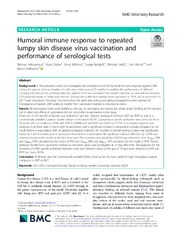Приказ основних података о документу
Humoral immune response to repeated lumpy skin disease virus vaccination and performance of serological tests
| dc.creator | Milovanović, Milovan | |
| dc.creator | Dietze, Klaas | |
| dc.creator | Milićević, Vesna | |
| dc.creator | Radojičić, Sonja | |
| dc.creator | Valčić, Miroslav | |
| dc.creator | Moritz, Tom | |
| dc.creator | Hoffmann, Bernd | |
| dc.date.accessioned | 2020-06-03T14:32:59Z | |
| dc.date.available | 2020-06-03T14:32:59Z | |
| dc.date.issued | 2019 | |
| dc.identifier.issn | 1746-6148 | |
| dc.identifier.uri | https://vet-erinar.vet.bg.ac.rs/handle/123456789/1732 | |
| dc.description.abstract | BackgroundIn the presented study we investigated the development of the humoral immune response against LSDV during the process of re-vaccination of cattle over a time span of 5 months. In addition, the performance of different serological techniques for antibody detection against LSDV was compared. For sample collection, an area without previous LSD outbreak reports in Serbia was selected. Seventy-nine cattle from twenty farms vaccinated in 2016 and re-vaccinated in 2017 were included in the study. Two farms from the same area with good calving management were selected for investigation of passive LSDV antibody transfer from vaccinated mothers to new-borne calves.ResultsAll investigated cattle were healthy on the day of vaccination and during the whole study. Swelling at the injection site or other side effects of vaccination did not occur after re-vaccination in the study.Detection of LSD-specific antibodies was performed with the standard serological methods VNT and IFAT as well as a commercially available Capripox double antigen multi-species-ELISA. Capripoxvirus-specific antibodies were detected 46 to 47weeks after vaccination in 2016, with VNT in 35.06% and with IFAT and ELISA in 33.77%. A secondary response was observed in all three tests 1 month after re-vaccination with a significant increase in seropositive animals compared to the results before re-vaccination. With all applied serological methods, the number of animals testing positive was significantly higher at 1 and 5 months post re-vaccination than before re-vaccination. No significant statistical difference (p>0.05) was observed between the results of all three tests used. The sensitivity and specificity of ELISA was estimated to be Se-ELISA 91% and Sp(ELISA) 87% calculated by the results of VNT and Se-ELISA 88% and Sp(ELISA) 76% calculated by the results of IFAT. Passive antibody transfer from vaccinated mothers to new-born calves was investigated at 14days after birth. Discrepancies for the detection of LSDV specific antibodies between cows and newborn calves at the age of 14days were observed in VNT and IFAT, but not in ELISA.ConclusionOf all tests used the commercially available ELISA shows to be the most useful for high throughput analysis compared to VNT or IFAT. | en |
| dc.publisher | BMC, London | |
| dc.relation | info:eu-repo/grantAgreement/MESTD/Technological Development (TD or TR)/31088/RS// | |
| dc.relation | info:eu-repo/grantAgreement/MESTD/Technological Development (TD or TR)/37015/RS// | |
| dc.rights | openAccess | |
| dc.rights.uri | https://creativecommons.org/licenses/by/4.0/ | |
| dc.source | BMC Veterinary Research | |
| dc.subject | LSD | en |
| dc.subject | LSDV | en |
| dc.subject | Humoral immunity | en |
| dc.subject | Passive antibody transfer | en |
| dc.subject | Secondary response | en |
| dc.subject | ELISA | en |
| dc.title | Humoral immune response to repeated lumpy skin disease virus vaccination and performance of serological tests | en |
| dc.type | article | |
| dc.rights.license | BY | |
| dcterms.abstract | Радојичић, Соња; Миловановић, Милован; Валчић, Мирослав; Милићевић, Весна; Хоффманн, Бернд; Моритз, Том; Диетзе, Клаас; | |
| dc.citation.volume | 15 | |
| dc.citation.spage | 80 | |
| dc.citation.other | 15: 80 | |
| dc.citation.rank | M21 | |
| dc.identifier.wos | 000460791600003 | |
| dc.identifier.doi | 10.1186/s12917-019-1831-y | |
| dc.identifier.pmid | 30841894 | |
| dc.identifier.scopus | 2-s2.0-85062584990 | |
| dc.identifier.fulltext | https://vet-erinar.vet.bg.ac.rs/bitstream/id/693/1731.pdf | |
| dc.type.version | publishedVersion |

